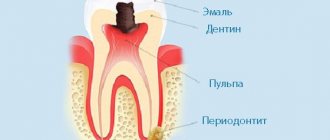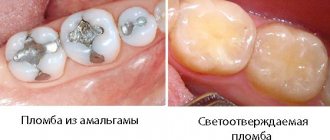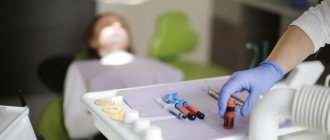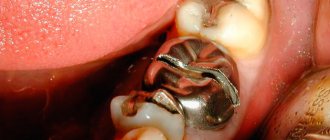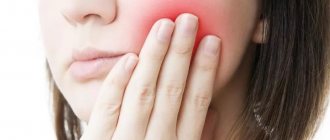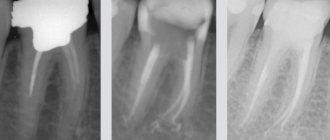Pain in teeth when chewing, what can cause it and how to treat it?
Toothache is dangerous and insidious; it can manifest itself in various ways and be a signal of a serious illness. In some cases, pain appears suddenly and for a short time, and sometimes it is present for a long time and causes great inconvenience and discomfort. Pain may occur during chewing, when pressing on the tooth or when tapping on it. Each type of toothache is a sign of some kind of inflammatory process in the oral cavity or tooth.
Pain in the teeth when chewing is one of the types of toothache that causes significant discomfort when eating. There are several reasons that can contribute to this type of pain.
Causes of toothache when chewing:
- presence of caries;
- crack in the tooth;
- violation of tooth enamel;
- damaged filling or crown structure;
- the presence of a damaged dental nerve;
- formation of a cyst in the tooth;
- periodontitis;
- periodontitis;
- pulpitis, etc.
Toothache when chewing is a signal of one of these processes. It is very difficult to independently determine the cause of pain, so if you have such pain, you must definitely seek help from a specialist so that he can make the correct diagnosis and prescribe treatment as soon as possible. Lack of proper and timely treatment can lead to unwanted complications and the development of serious diseases.
Toothache after filling
2943 March 25
IMPORTANT!
The information in this section cannot be used for self-diagnosis and self-treatment.
In case of pain or other exacerbation of the disease, diagnostic tests should be prescribed only by the attending physician. To make a diagnosis and properly prescribe treatment, you should contact your doctor. Toothache: causes of occurrence, what diseases it occurs with, diagnosis and treatment methods.
Definition
After filling a cavity or canal of a tooth, pressing or bursting pain may occur. Sometimes pain occurs when biting, chewing and tapping a tooth; in some cases, the pain becomes acute with the development of swelling of the gums in the area of the causative tooth.
Types of toothache after filling
Depending on the cause of the appearance, local or diffuse toothache after filling is distinguished. More often it is transient and goes away on its own after a short time (no more than a day).
In some patients, after filling a carious cavity with deep caries or a canal with pulpitis, the intensity of pain gradually increases, it can be paroxysmal in nature, intensify under the influence of cold, and radiate along the branches of the trigeminal nerve. If left untreated, such pain becomes throbbing, the tooth may react to hot food, and swelling and redness of the gums develop. An infiltrate may form on the gum, from which pus or an abscess flows out when opened.
Possible causes of toothache after filling
Impact of irritants on the pulp.
First of all, you need to understand the location, intensity of pain and under what circumstances it occurs. If pain appears immediately after installation of a filling, this may be a consequence of the reaction of the nerves of the tooth and periapical tissues (tissues surrounding the root of the tooth) to mechanical, thermal and chemical influences.
Pain after the cessation of anesthesia indicates restoration of tissue sensitivity. As a rule, discomfort disappears within 24 hours after treatment.
Sometimes strong drugs placed into the tooth cavity lead to overdrying of dentin (the main solid substance of the tooth surrounding the pulp) and even to chemical burns of the pulp. This complication is accompanied by an acute pain reaction to cold and hot foods and sweets.
Incorrect installation of the seal
. If the upper border of the filling protrudes above the chewing surface of the tooth, then all the pressure of the opposite jaw during chewing falls on one tooth. This leads to overload of the ligamentous apparatus of the tooth, injury to the periapical tissues and the occurrence of dull local pain during chewing. To prevent such a complication, the doctor, after installing the filling, conducts a test with carbon paper. The paper is placed on the tooth with a filling and the patient is asked to close the jaws and make lateral and anteroposterior movements. The cusps of the tooth, which are marked with carbon paper, are ground off.
It is a mistake to think that excess filling material will wear off on its own over time.
The process of natural grinding lasts for years, during which time the patient experiences pain when chewing and, ultimately, this leads to traumatic periodontitis (inflammation of the tissues surrounding the tooth). Inflammation of the periapical tissues
and the appearance of pain may be a consequence of pushing the filling material beyond the apex of the root canal. Together with the filling mass, infected tissues from the tooth canal enter the periodontium, which cause periodontitis. In this case, prolonged aching pain occurs, which intensifies when pressing on the diseased tooth. Tapping on a tooth is painful. Nearby lymph nodes (for example, submandibular) may enlarge. There is a risk of accumulation of purulent exudate in the area of the root apex and the formation of an abscess. The gums near the diseased tooth swell and turn red. Sometimes pus breaks through the gum, in these cases the swelling, redness and pain decrease. However, without treatment, this process constantly recurs.
Pain after filling can also occur in cases where one of the canals extending from the pulp chamber remains untraversed.
The number and location of canals in multi-rooted teeth varies from person to person.
If during tooth sanitation one of the canals remains unnoticed, the infection from it penetrates into the periodontium with the development of chronic periodontitis.
Close location of the carious cavity to the dental pulp
. In some cases, the bottom of the cavity is located too close to the pulp. The thin intermediate layer of dentin is penetrated by short tubes, through which infection from the carious cavity can enter the pulp and cause its inflammation (pulpitis). In these cases, hyperemia of the pulp develops (the initial stage of pulpitis), which, if left untreated, turns into acute pulpitis. There is no pain when tapping on the causative tooth.
A characteristic sign of initial pulpitis is pain that occurs upon contact with irritants (temperature and chemical) and goes away a few minutes after the cessation of their influence.
In other cases, the doctor may not recognize the initial stage of pulpitis when filling a tooth. In this case, sealing the infected pulp leads to acute pulpitis, which is accompanied by sharp, paroxysmal pain, intensifying at night and radiating along the branches of the trigeminal nerve.
Which doctors should I contact for toothache after filling?
If pain occurs immediately after dental treatment, you should contact your dentist. However, in some cases, when there are no signs of malocclusion and periodontitis and pulpitis are not observed on radiographs, the patient may be referred for consultation to an otolaryngologist (if sinusitis is suspected) or (if inflammation of the trigeminal nerve is suspected).
Diagnosis and examination for toothache after filling
The connection between the occurrence of pain and previous dental treatment helps to make a preliminary diagnosis. The presence of an inflammatory process is confirmed by redness and swelling of the gums.
However, accurate diagnosis is only possible after radiography.
In the absence of clear radiological signs of periodontitis, they resort to electroodontodiagnostics (a method for assessing the condition of the pulp, in which its reaction to a weak electric current is checked), it allows one to assess the degree of damage to the pulp.
What to do if you have toothache after filling
Mild, aching pain after tooth treatment may continue for 1-2 days, and this is normal.
However, if the pain does not subside or intensifies, a consultation with a dentist is necessary to diagnose possible complications.
Treatment of toothache after filling
If the pain is caused by malocclusion due to excess filling material, it should be sanded off.
Pain due to the development of pulpitis requires opening the pulp chamber and depulping the tooth. Acute and chronic periodontitis also indicates the need for unfilling of root canals and their mechanical and medicinal treatment. After treating the cavity and canals, the doctor can apply therapeutic and insulating linings, covering the tooth with a temporary filling, then another visit will be required so that the doctor can re-treat the cavity and place a permanent filling.
Sources:
- Clinical recommendations (treatment protocols) for the diagnosis of periapical tissue disease // Moscow State Medical and Dental University named after. A.I. Evdokimov of the Ministry of Health of the Russian Federation. – 2014.
- Therapeutic dentistry: Textbook / ed. Borovsky E.V. – M.: Medical Information Agency. 2004. - 400 p.
IMPORTANT!
The information in this section cannot be used for self-diagnosis and self-treatment. In case of pain or other exacerbation of the disease, diagnostic tests should be prescribed only by the attending physician. To make a diagnosis and properly prescribe treatment, you should contact your doctor.
Ways to treat and reduce tooth pain when chewing
If you experience pain while chewing food, you should immediately seek help, without waiting for the pain to go away on its own or for additional unpleasant symptoms to appear, such as temperature and swelling, which indicate the presence of a significant inflammatory process in the body. However, if it is not possible to go to the dentist in the near future, you can independently relieve the pain and stop the development of inflammation with the help of a few simple procedures.
Ways to reduce pain when chewing:
- rinse the mouth with herbal tinctures or soda solution;
- make tooth lotions from mint, cloves or sea buckthorn oil;
- After each meal, use dental floss and rinse your mouth to get rid of food debris;
- to disinfect the oral cavity, keep onion peel tincture in your mouth for 20 minutes;
- for acute pain, you can take a painkiller, for example spasmolgon, analgin, nurofen, etc.
These methods will help reduce pain before visiting a doctor. However, it is impossible to cure the cause of toothache with their help, so it is necessary to seek qualified help as soon as possible in order not to aggravate the situation and prevent the development of other oral diseases.
Degree of severity and location of pain
The throat may hurt a little or just unbearably. At the same time, burning, soreness, dryness, a feeling of a lump, scratching, and a change in voice are possible. The patient almost always has a fever. Against this background, weakness, body aches, and lack of appetite appear. Such symptoms are a manifestation of various pathologies.
There are many reasons why pain occurs when yawning:
cold;- injuries;
- infections;
- weakened immunity;
- age;
- joint diseases;
- dental problems;
- neuromuscular disorders, etc.
Pain sensations can be cutting – in case of injuries; sharp – for inflammation, infections; stupid - if we are talking about a tumor. But it is wrong to make a diagnosis based on the nature of the pain; additional research methods are needed.
It is imperative to take into account the location of the painful manifestations: this sign will tell the doctor a lot.
When the throat hurts on one side, we can say with a high degree of probability that this is a local disease: sore throat, laryngitis, pharyngitis or an abscess. If on both sides, this may be a manifestation of varicose veins of the esophagus, diseases of the kidneys, thyroid gland, circulatory system (including cancer), arthrosis of the temporomandibular joint, etc. Pain at the bottom of the throat may indicate inflammation of the epiglottis. Deep in the larynx - about a problem with the pharynx, larynx, parathyroid glands, even neck muscles. Sometimes when you yawn, your ear also hurts; this is an alarming symptom and may indicate brain damage.
If a tooth hurts that has never been treated
1. Pain that occurs with pressure may mean the development of inflammation from the root of the tooth or hidden caries. Carious lesions can be so deep that they affect the pulp, which reacts when pressure is applied to the tooth with acute, severe pain. If symptoms appear only during a bite and then go away spontaneously, a quick visit to the dentist who will carry out conservative treatment will be the most correct solution to the problem.
However, it should be remembered that ignoring pain by the patient sooner or later ends in acute pulpitis and the need for root canal treatment!
2. Toothache appears during pressure, but after the pressure stops, the tooth does not stop hurting; on the contrary, the discomfort intensifies, especially at night, when the person is in a horizontal position. These symptoms suggest damage to the pulp - in this situation, the dentist has two options: root canal treatment or tooth extraction followed by its restoration (classical prosthetics or installation of a prosthesis on an implant).
Causes of tooth pain when pressed
Quite often, painful sensations occur after filling. It is worth noting that this is a normal reaction of the body, and all pain goes away on its own after a few days. In some cases, mild pain may persist for up to a week.
If the pain only intensifies over time, then this indicates some kind of disorder. The placed filling can disrupt the closure of the dentition and increase the mechanical load on the tooth. If filling is performed using a photopolymer lamp, overheating of the pulp or even burns may occur. Acid can also damage the bone tissue of the tooth and cause pain. The same result is possible if the filling was placed incorrectly. If the doctor does not completely clean the carious lesion, secondary caries may appear.
Also, pain can be caused by an error when cleaning the canals. In this case, a very thin endodontic instrument is used, which can break. If the slightest fragment remains in the canal, then over time an inflammatory process will begin in the oral cavity.
Content:
- Causes of tooth pain when pressed
- Healthy tooth under pressure
- Soreness after treatment
One common cause is damage to the walls of the tooth root. If such a case occurs, it can be seen on an x-ray.
Not all people know that even a tooth that lacks a nerve can hurt. When filling a canal, the material may get beyond the upper part of the tooth root, thereby causing irritation of the tissues around the tooth. The result is pain when biting.
People often encounter this problem when the tooth under the crown hurts when biting. In this case, there are several causes of pain. First of all, poor-quality tooth processing: unprofessional grinding. It can also hurt if there are chips or cracks on the crown, if the wrong size of the microprosthesis was initially selected. In addition, it is possible to wash out the cement under the crown. Thus, the fixation of the prosthesis is disrupted, and food and bacterial plaque accumulate under it. It is important to remember that the crown needs to be changed on time, because its service life is approximately 5 years. Therefore, if the pain occurs under the crown, then the reason may be that the crown is too old. After the crown is installed, the tooth may hurt when pressed for several days. If the pain continues longer, then you need to see a dentist.
